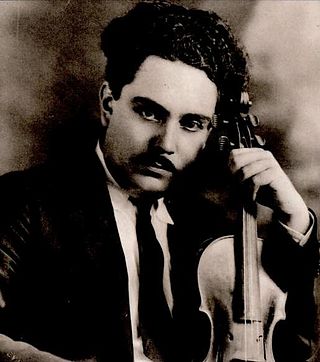
Silvestre Revueltas Sánchez was a Mexican classical music composer, a violinist, and conductor.
Sensemayá is a composition for orchestra by the Mexican composer Silvestre Revueltas, which is based on the poem of the same title by the Cuban poet Nicolás Guillén. It is one of Revueltas's most famous compositions.
Daniel Ayala Pérez was a Mexican violinist, conductor, and composer.

Enrique Arturo Diemecke is a Mexican conductor, violinist and composer. He is currently the Artistic General Director of the Teatro Colón in Buenos Aires and music director of the Buenos Aires Philharmonic and the Flint Symphony Orchestra in Michigan, United States.
Enrico Chapela is a Mexican contemporary classical composer, whose works have been played by multiple major orchestras and has been commissioned to compose for institutions such as the Los Angeles Philharmonic, the National Center for the Performing Arts (Beijing) and the Festival Internacional Cervantino. His work is influenced by modern popular musical styles such as rock and electronic, as well as Mexican popular culture.
Gabriela Ortiz is a Mexican music educator and composer.
The Night of the Mayas is a 1939 Mexican film directed by Chano Urueta. The film, which is called a "Mexican tragedy" set in the times of the Mayas, is remembered today for its musical score by the Mexican composer Silvestre Revueltas.
Sinfonía de Antígona is Carlos Chávez's Symphony No. 1, composed in 1933. The music originated as theatre music to accompany the tragedy of Antigone, hence the title of the symphony. The material was reworked into a single movement and rescored for a large orchestra. It lasts about 11 minutes in performance.

Sinfonía india is Carlos Chávez's Symphony No. 2, composed in 1935–36. In a single movement, its sections nevertheless follow the traditional pattern for a three-movement symphony. The title signifies the fact that the thematic material consists of three melodies originating from native-American tribes of northern Mexico. The symphony is Chávez's most popular composition.
Symphony No. 4, subtitled Sinfonía romántica is an orchestral composition by Carlos Chávez, composed in 1953.

Symphony No. 5, also called Sinfonía para cuerdas is a composition for string orchestra by Carlos Chávez, composed in 1953.

Janitzio is a symphonic poem by the Mexican composer Silvestre Revueltas, composed in 1933 and revised in 1936. A performance lasts about 15 minutes. The work is a portrait of Janitzio Island in Lake Pátzcuaro, Mexico.

Colorines is a symphonic poem for chamber orchestra by the Mexican composer Silvestre Revueltas, written in 1932.
Salvador Contreras Sánchez was a Mexican composer and violinist, a member of the Grupo de los cuatro.

Planos (Planes) is a chamber-music composition by the Mexican composer Silvestre Revueltas, also slightly enlarged and scored for full orchestra and published under its alternate title, Danza geométrica. Both versions were composed in 1934, and the scores are both dedicated to the architect Ricardo Ortega.

Cuauhnáhuac is an orchestral composition by the Mexican composer Silvestre Revueltas. It exists in three versions, the first for string orchestra, the other two for full orchestra with winds and percussion. The first version takes nearly 15 minutes to perform, while the third lasts only about 11 minutes.

Ventanas (Windows) is an orchestral work by the Mexican composer Silvestre Revueltas, written in 1931. A performance of it lasts about 11 minutes.

Esquinas (Corners) is an orchestral composition by the Mexican composer Silvestre Revueltas, written in 1931 and extensively revised in 1933. The first version is in two movements with a duration of about 11 minutes in performance; the second is variously described as being in one or in three (continuous) movements with a total duration of about seven minutes. The scores of both versions are dedicated to Ángela Acevedo.

Alcancías is a composition for small orchestra by the Mexican composer Silvestre Revueltas, written in 1932. It is in three movements with a total duration in performance of about eight minutes.





